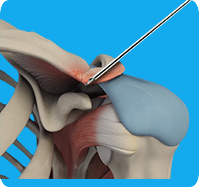
Anterior Shoulder Instability
Anterior shoulder instability, also known as anterior glenohumeral instability, is a condition in which damage to the soft tissues or bone causes the head of the humerus (upper arm bone) to dislocate or sublux from the glenoid fossa, compromising the function of the shoulder. It is caused by trauma or injury to the glenohumeral joint in which the upper arm bone is dislodged from its usual position in the middle of the glenoid fossa, and there is no longer joint articulation.

Posterior Shoulder Instability
Posterior shoulder instability, also known as posterior glenohumeral instability, is a condition in which the head of the humerus (upper arm bone) dislocates or subluxes posteriorly from the glenoid (socket portion of the shoulder) as a result of significant trauma. A partial dislocation is referred to as a subluxation whereas a complete separation is referred to as a dislocation.

Multidirectional Instability of the Shoulder
Instability may be described by the direction in which the humerus is subluxated or dislocated from the glenoid. When it occurs in several directions it is referred to as multidirectional instability. Multidirectional instability is diagnosed with the help of specific tests. Imaging tests such as an X-ray or an MRI scan help visualize the shoulder joint and its supportive structures.

Shoulder Labral Tear with Instability
The shoulder consists of a ball-and-socket joint formed by the upper end of the humerus (upper arm bone) and a cavity in the shoulder blade called the glenoid. The glenoid cavity is surrounded by a rim of cartilage called the labrum. The labrum adds depth to the cavity making the joint more stable and positions the ball within the socket.

SLAP Tears
The term SLAP (superior –labrum anterior-posterior) lesion or SLAP tear refers to an injury of the superior labrum of the shoulder. The most common causes include falling on an outstretched arm, repetitive overhead actions such as throwing and lifting a heavy object. Overhead and contact sports may put you at a greater risk of developing SLAP tears.

Open Shoulder Stabilization
Open shoulder stabilisation is a surgical procedure performed to treat a condition called shoulder instability. Shoulder instability is a chronic condition that causes the frequent dislocation of the shoulder joint. A dislocation occurs when the end of the humerus (the ball portion) partially or completely dislocates from the glenoid (the socket portion) of the shoulder.

Anterior Shoulder Stabilization
Anterior shoulder instability, also known as anterior glenohumeral instability, is a shoulder condition in which damage to the soft tissues or bone causes the head of the humerus (upper arm bone) to dislocate or sublux from the glenoid fossa, compromising the function of the shoulder. A dislocation occurs when the end of the humerus (the ball portion) partially or completely dislocates from the glenoid (the socket portion) of the shoulder. A partial dislocation is referred to as a subluxation while a complete separation is referred to as a dislocation.

Posterior Shoulder Stabilization
Posterior shoulder instability, also known as posterior glenohumeral instability, is a condition in which the head of the humerus (upper arm bone) dislocates or subluxes posteriorly from the glenoid (socket portion of the shoulder) as a result of significant trauma, compromising shoulder function. A partial dislocation is referred to as a subluxation whereas a complete separation is referred to as a dislocation. The repeated dislocation of the humerus out of its socket is called chronic shoulder instability.

Arthroscopic Bankart Repair
Young people who have sustained a dislocation of the shoulder may experience a specific type of labral tear called a Bankart tear. The condition usually occurs during a shoulder injury. The labrum can sometimes tear during a shoulder injury. A specific type of labral tear that occurs when the shoulder dislocates is called a Bankart tear.

Shoulder Labrum Reconstruction
The shoulder joint is a ball and socket joint. A ball at the top of the upper arm bone (the humerus) fits neatly into a socket, called the glenoid, which is part of the shoulder blade (scapula). The labrum is a ring of fibrous cartilage surrounding the glenoid, which helps in stabilising the shoulder joint. The biceps tendon is attached inside the shoulder joint at the superior labrum of the joint.

AC Joint Stabilization
Acromioclavicular (AC) joint stabilisation is a surgical procedure employed to treat severe cases of AC joint dislocation. AC joint dislocation is the separation of the collar bone or clavicle from the acromion (the top portion of the shoulder blade or scapula at the outer edge of the shoulder) due to severe trauma.
